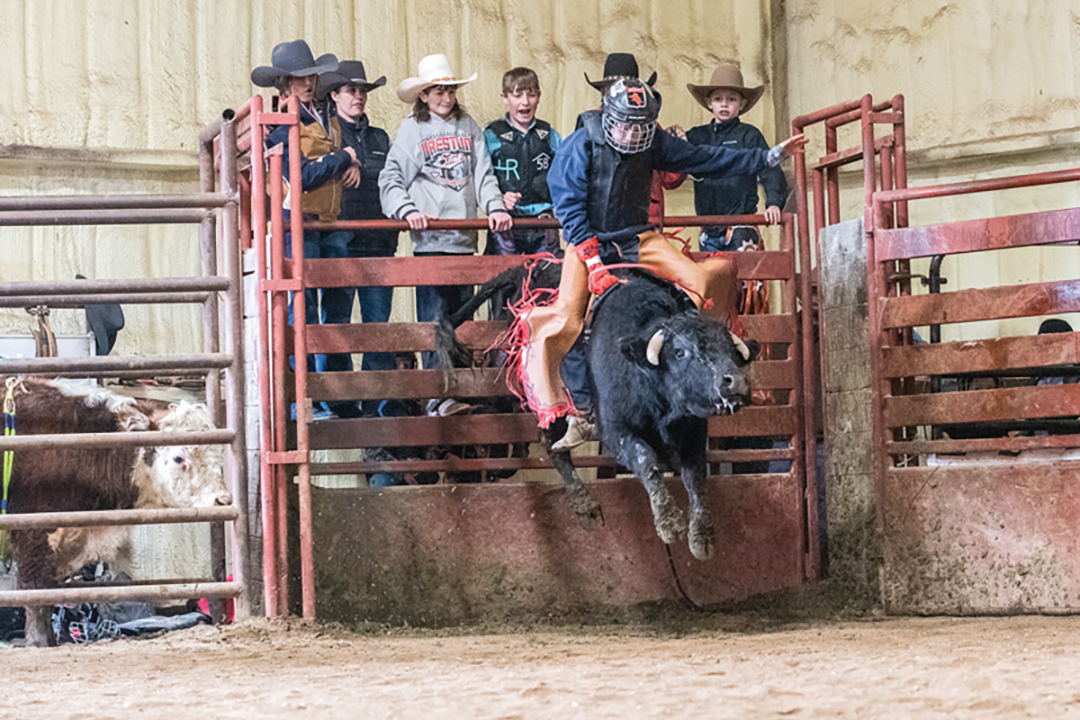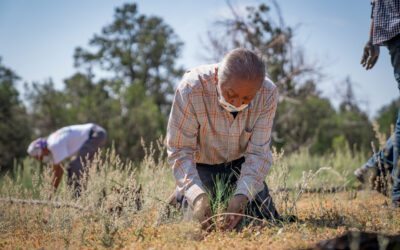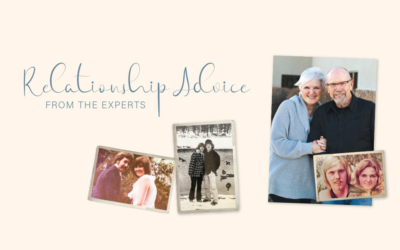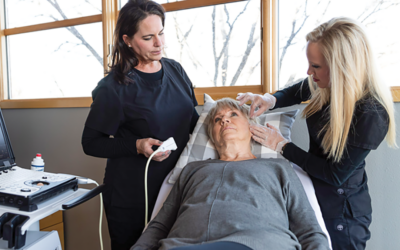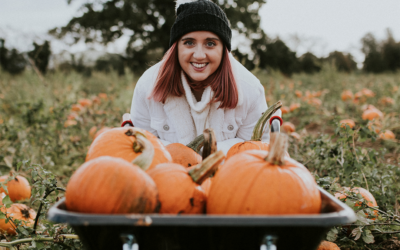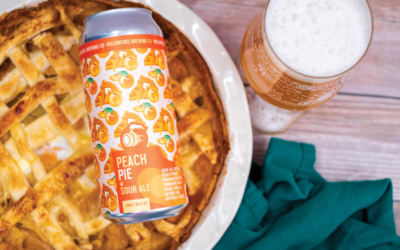When a friend asked Koda Kling last summer to teach his son how to ride bucking bulls, the former bull rider thought he’d spend an afternoon with the 12-year-old setting ropes through the rails of a bull pen. But word travels fast in the rodeo world.
By the end of last summer, there were 25 kids ages 5-17 participating in biweekly classes, and Spur Ride Rodeo Co. was born with the intention of coaching kids in bull riding.
These days, Kling must turn away kids who want those 8 seconds of excitement and fear sitting astride 1,200-pounds of fury.

Zeke Mora and Cody Johansen help Gatlin Hermanson ride a bull at a Spur Ride Rodeo session. Photos by Quicksand Photography.
He says his wife, Kendra, nudged him to coach. He bought three bulls, ages 3 to 8, and another friend bought one, too. The company now has eight bulls total: each bull costs between $700 to $850. He charges kids $20 per bull to ride, using another friend’s 140-acre property and arena to range and house the animals. Kling’s day job with an oil field services company, Advanced Contracting Group, helps because they provide some underwriting for the school. There’s also rope donations from MX Bull Ropes.
In return, kids invest in gear, including a vest, helmet, chaps and ropes, for $750.
Each of the bulls are handpicked by Kling and his team.
“We stay away from every bull that’s mean, although we do have some that like to ‘play rodeo,’” says Kling. Kling describes one such beast: “He’ll flick his head at you like he’s going to hook you but he’s bluffing. He’s not a fire-breathing dragon like people think of when they think of bulls. He’ll kind of bump you and then move on with his day. We’re trying to make this as safe as we can— inherently, it’s a dangerous sport, but we try to mitigate some of the hazards.” Kling rode for 16 years and says back then, practice bulls didn’t exist.
“When I was 11 years old, I was getting my butt handed to me because there was nothing out there that was easy to ride,” he says. “We learned to ride bulls at the rodeos. Our bulls aren’t going to run you down as soon as you come off them.”
He compares his bullring to the bunny slopes for skiers.
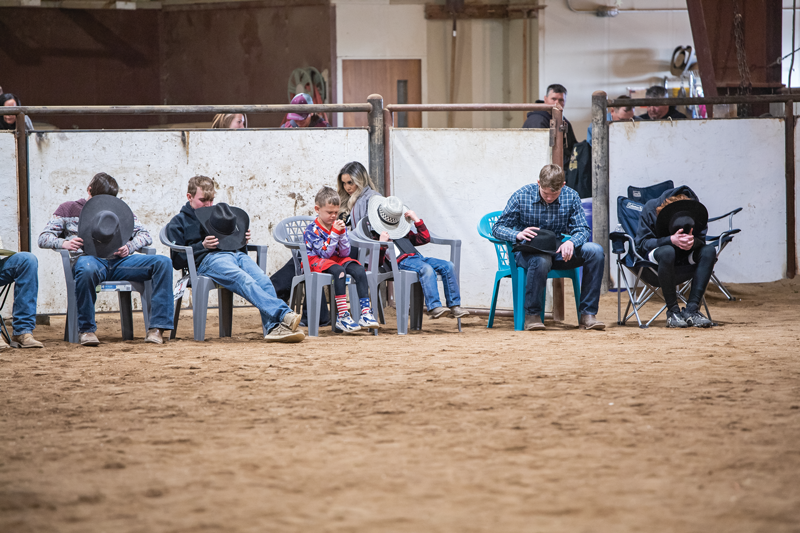
Brennan Robison, Wyatt Applegate, Camden Walter, Waylon Horning and Jayton Cordova participate in the devotional segment during
“When kids come to my place, I’ve got black diamonds, a bunny slope and everything in between,” he says.
As much as Kling hopes kids learn the sport, he believes the number-one thing separating his company from other practice pens is the team meeting during an intermission in riding.
“It could be a rodeo lesson, sometimes it’s how to be a good person, sometimes it focuses on the devotional,” he says.
On a frigid Wednesday night in February, when temperatures hovered around 5 degrees in the unheated arena outside of Kersey, the topic was Ephesians 6:10-11, a segment about donning spiritual armor to guard against temptations.
“We do the same thing when we ride,” he told the group of youngsters. “The gloves protect our hands from blisters, spurs help us stay on and not get underneath the bull, and we wear a helmet.”
Kling requires that his coaches and parents take an NFHSLearn.org class on concussion protocols offered by the high school athletics advocate.
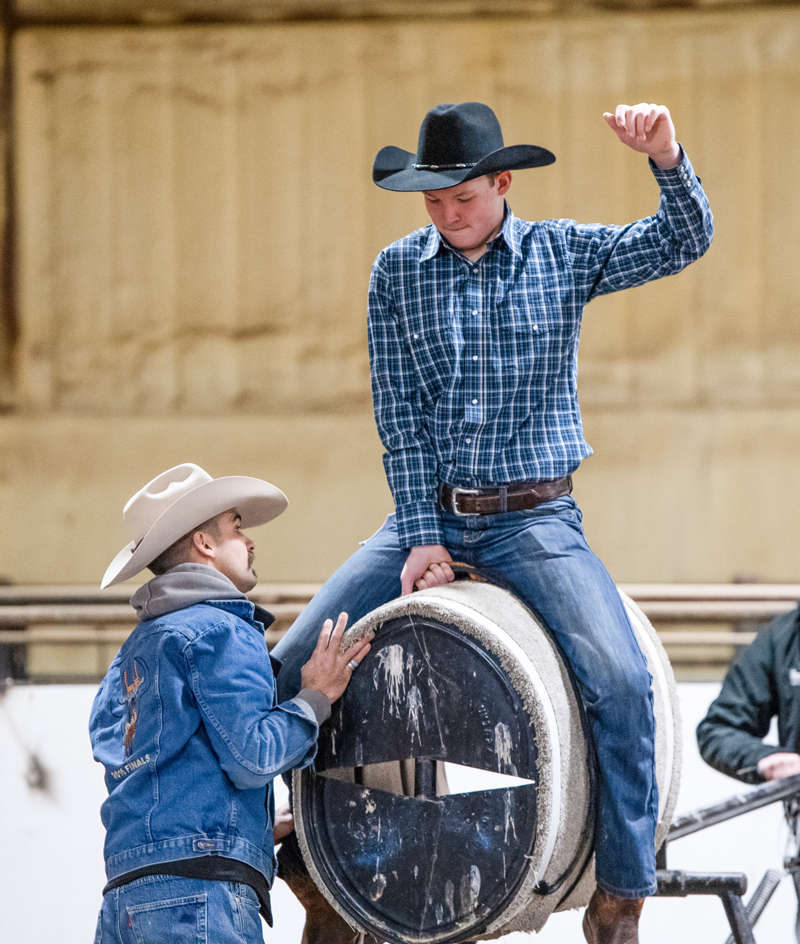
Zeke Mora teaches Jayton Cordova bull riding techniques using a barrel mock up.
“I’ve had at least 12 friends get head injuries and eventually died from those— often it was suicide,” he says. “I’m doing what I can to slow that curve.”
Kling pivots the devotional back to rodeo with an admonition: for rodeo riders, creasing your jeans, tucking in your shirt, wearing a cowboy hat—not a baseball cap worn backwards—and being polite are part and parcel of rodeo professionalism.
“If you go into a Wendy’s, you never know who’s standing in line behind you. It could be a sponsor, it could be the mayor’s wife. If your shirt’s untucked and you look like slobs or you’re being rude, next year when the rodeo committee asks if they can have another rodeo in town, they’ll remember those rude kids and say no,” he says.
Kling recalls his rodeo days when he traveled on the road and learned by doing, including things as simple as where to stay the night, what time to eat and where to eat to save money.
Kim Schroeder’s son, Merik Young, is 12 and has been riding bulls for six years. She thinks he’s ridden over 100 bulls at this point, acknowledging that Merik has no fear.
“Raising Merik is not for the faint of heart,” she says and chuckles.
Young hopes the life lessons might help him mentor other people someday.
“Koda teaches us how to act at rodeos, how to tie our bull ropes, how to carry yourself in public, like don’t go around making a fool of yourself. Be respectful, make yourself proud,” Young says.
His mom says family and faith are a big part of what defines rodeo culture.
“It’s really scary watching your kid, traveling places and still taking care of the rest of your family. I don’t know if you could make it work without the solid foundation of the community—they’re salt of the earth people, solid workingclass families. It matches up with our values of helping others out when you can, supporting each other,” she says. “I get less nervous now. Merik’s learned a lot. You don’t want to end up underneath a bull or smashed into a fence.”
Kling says he recognizes some of the kids he coaches might have rough lives at home. He hopes to get them more prepared before they head out into the world to rodeo.
He hopes he’s instilling a sense of camaraderie and a sense of the spiritual importance of living right, too.
“I might be the only place they can go to get a little bit of Jesus talk. The number-one goal is that,” he says. “The number-two goal is riding bulls.”


